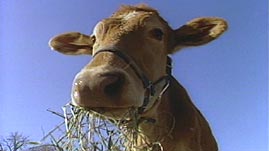Finding a meal would be a lot easier, not to mention cheaper, if we could
simply step outside and graze. But a meal made up of grass and leaves
would not only offend your taste buds, it would probably give you a pretty
bad stomach ache. So why is it that adults are always pushing greens on
kids when humans couldn't possibly survive on a diet of grass or leaves
alone?
All plants are made, in part, of a very complex
carbohydrate called cellulose. This is the material that gives plants
their strength, their ability to stand tall even though they have no
bones. Cellulose provides structure by surrounding each cell with a tough
wall. Cellulose in foods is usually called dietary fiber. Eating fruits
and vegetables, which contains relatively small amounts of cellulose,
helps to keep our digestive systems healthy. Fruits and vegetables are
also good sources of vitamins and other nutrients that can't easily be
found elsewhere.
Unlike fruits and vegetables, most plant
material is low in nutrients and extremely high in cellulose. There is
simply too little digestible material in most plant tissue to sustain
a human, no matter how much of it is consumed.
Animals like cattle, sheep, goats, giraffes, and camels, otherwise known as
ruminants, grow fat and healthy on just such a diet. That is because
they have a digestive system that is very different from our own. Most
scientists describe the typical ruminant digestive tract as having
four distinct stomachs -- the rumen, reticulum, omasum, and abomasum --
linked together in that order.
Even with multiple stomachs,
ruminants would be unable to digest cellulose if they didn't have a lot of
help. Inside the first two stomachs of a typical ruminant live billions of
bacteria and protozoans. These single-celled organisms possess a chemical
that ruminants (and humans) lack, a digestive enzyme called cellulase
that breaks down cellulose.
In keeping with their name,
ruminants typically spend six to eight hours each day ruminating -- a
process that involves regurgitating boluses of previously eaten food,
called cuds, rechewing them, and swallowing them again. This helps to
break the food down physically into increasingly smaller pieces and
also gives the microorganisms in the ruminants' stomachs ample time to
further break the food down chemically.

 Loading Standards
Loading Standards Teachers' Domain is proud to be a Pathways portal to the National Science Digital Library.
Teachers' Domain is proud to be a Pathways portal to the National Science Digital Library.
